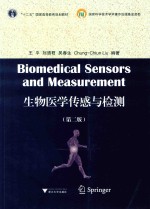

生物医学传感与检测 第2版PDF电子书下载
- 电子书积分:11 积分如何计算积分?
- 作 者:王平,刘清君,吴春生编著
- 出 版 社:杭州:浙江大学出版社
- 出版年份:2016
- ISBN:9787308151269
- 页数:293 页
Chapter 1 Introduction 1
1.1 Definition and Classification of Biomedical Sensors 1
1.1.1 Basic Concept of Sensors 1
1.1.2 Classification ofBiomedical Sensors 2
1.2 Biomedical Measurement Technology 2
1.2.1 Bioelectrical Signal Detection 3
1.2.2 Biomagnetic Signal Detection 3
1.2.3 Other Physiological and Biochemical Parameter Detection 4
1.3 Characteristics of Biomedical Sensors and Measurement 4
1.3.1 Features ofBiomedical Sensors and Measurement 5
1.3.2 Special Requirements ofBiomedical Sensors and Measurement 5
1.4 Development of Biomedical Sensors and Measurement 6
1.4.1 Invasive and Non-Invasive Detection 7
1.4.2 Multi-Parameter Detection 7
1.4.3 In vitro andIn vivo Detection 8
1.4.4 Intelligent Artificial Viscera 9
1.4.5 Micro-Nano Systems 10
1.4.6 Biochips and Microfluidics 11
1.4.7 Biomimetic Sensors 11
References 12
Chapter 2 Basics of Sensors and Measurement 13
2.1 Introduction 13
2.2 Sensor Characteristics and Terminology 14
2.2.1 Static Characteristics 14
2.2.2 Dynamic Characteristics 16
2.3 Sensor Measurement Technology 19
2.3.1 Measurement Methods 19
2.3.2 Sensor Measurement System 21
2.3.3 Signal Modulation and Demodulation 23
2.3.4 Improvement of Sensor Measurement System 30
2.4 Biocompatibility Design of Sensors 31
2.4.1 Concept and Principle of Biocompatibility 31
2.4.2 Biocompatibility for Implantable Biomedical Sensors 34
2.4.3 Biocompatibility for In vitro Biomedical Sensors 36
2.5 Microfabrication of Biomedical Sensors 39
2.5.1 Lithography 39
2.5.2 Film Formation 39
2.5.3 Etching 40
2.5.4 Design of the Biomedical Sensors 42
References 44
Chapter 3 Physical Sensors and Measurement 47
3.1 Introduction 47
3.2 Resistance Sensors and Measurement 48
3.2.1 Resistance Strain Sensors 48
3.2.2 Piezoresistive Sensors 59
3.3 Inductive Sensors and Measurement 62
3.3.1 Basics 62
3.3.2 Applications in Biomedicine 80
3.4 Capacitive Sensors and Measurement 81
3.4.1 The Basic Theory and Configuration of Capacitive Sensors 81
3.4.2 Measurement Circuits 87
3.4.3 Biomedical Applications 90
3.5 Piezoelectric Sensors and Measurement 96
3.5.1 Piezoelectric Effect 96
3.5.2 Piezoelectric Materials 98
3.5.3 Measurement Circuits 99
3.5.4 Biomedical Applications 102
3.6 Magnetoelectric Sensors and Measurement 106
3.6.1 Magnetoelectric Induction Sensors 106
3.6.2 Hall Magnetic Sensors 110
3.7 Photoelectric Sensors 115
3.7.1 Photoelectric Element 115
3.7.2 Fiber Optic Sensors 123
3.7.3 Applications of Photoelectric Sensors 124
3.8 Thermoelectric Sensors and Measurement 126
3.8.1 Thermosensitive Elements 126
3.8.2 Thermocouple Sensors 128
3.8.3 Integrated Temperature Sensors 130
3.8.4 Biomedical Applications 132
References 134
Chapter 4 Chemical Sensors and Measurement 137
4.1 Introduction 137
4.1.1 History 137
4.1.2 Definition and Principle 139
4.1.3 Classification and Characteristics 139
4.2 Electrochemical Fundamental 140
4.2.1 Measurement System 140
4.2.2 Basic Conception 142
4.2.3 Classification of Electrodes 147
4.3 Ion Sensors 149
4.3.1 Ion-Selective Electrodes 149
4.3.2 Ion-Selective Field-Effect Transistors 155
4.3.3 LightAddressable Potentiometric Sensors 159
4.3.4 Microelectrode Array 163
4.4 Gas Sensors 167
4.4.1 Electrochemical Gas Sensors 167
4.4.2 Semiconductor Gas Sensors 170
4.4.3 Solid Electrolyte Gas Sensors 177
4.4.4 Surface Acoustic Wave Sensors 180
4.5 Humidity Sensors 183
4.5.1 Capacitive Humidity Sensors 184
4.5.2 Resistive Humidity Sensors 185
4.5.3 Thermal Conductivity Humidity Sensors 186
4.5.4 Application 187
4.6 Intelligent Chemical Sensor Arrays 189
4.6.1 e-Nose 189
4.6.2 e-Tongue 196
4.7 Micro Total Analysis System 201
4.7.1 Design and Fabrication 201
4.7.2 Applications 209
4.8 Sensor Networks 209
4.8.1 History of Sensor Networks 210
4.8.2 Essential Factors of Sensor Networks 210
4.8.3 Buses of Sensor Networks 211
4.8.4 Wireless Sensor Network 214
References 219
Chapter 5 Biosensors and Measurement 223
5.1 Introduction 223
5.1.1 History and Concept of Biosensors 223
5.1.2 Components of Biosensor 224
5.1.3 Properties of Biosensors 226
5.1.4 Common Bioreceptor Components 226
5.2 Catalytic Biosensors 227
5.2.1 Enzyme Biosensors 227
5.2.2 Microorganism Biosensors 231
5.3 Affinity Biosensors 233
5.3.1 Antibody and Antigen Biosensors 233
5.3.2 Nucleic Acid Biosensors 240
5.3.3 Receptor and Ion Channel Biosensors 244
5.4 Cell and Tissue Biosensors 247
5.4.1 Cellular Metabolism Biosensors 248
5.4.2 Cellular Impedance Biosensors 251
5.4.3 Extracellular Potential Biosensors 254
5.5 Biochips 258
5.5.1 Chips of Microarray 259
5.5.2 Gene and Protein Chips 259
5.5.3 Tissue and Cell Chips 264
5.5.4 Lab-on-a-Chip 266
5.6 Nano-Biosensors 268
5.6.1 Nanomaterials for Biosensors 269
5.6.2 Nanoparticles and Nanopores Biosensors 270
5.6.3 Nanotubes and Nanowires Biosensors 278
References 284
Index 289
- 《生物质甘油共气化制氢基础研究》赵丽霞 2019
- 《奶制品化学及生物化学》(爱尔兰)福克斯(FoxP.F.)等 2019
- 《生物化学》田余祥主编 2020
- 《微生物培养与显微检验》李晶主编 2018
- 《医学物理学》洪洋 2020
- 《小牛顿科学故事馆 医学的故事》小牛顿科学教育公司编辑团队 2018
- 《灭绝生物的故事》小牛顿科学教育公司编辑团队编著 2018
- 《高等医药院校教材 医学物理学实验指导》(中国)杨晓岚 2019
- 《中华医学百科全书 中医内科学》(中国)刘德培 2019
- 《海州湾生态环境与生物资源》晁敏主编 2018
- 《大学计算机实验指导及习题解答》曹成志,宋长龙 2019
- 《浙江海岛植物原色图谱》蒋明,柯世省主编 2019
- 《大学生心理健康与人生发展》王琳责任编辑;(中国)肖宇 2019
- 《大学英语四级考试全真试题 标准模拟 四级》汪开虎主编 2012
- 《大学英语教学的跨文化交际视角研究与创新发展》许丽云,刘枫,尚利明著 2020
- 《复旦大学新闻学院教授学术丛书 新闻实务随想录》刘海贵 2019
- 《大学英语综合教程 1》王佃春,骆敏主编 2015
- 《美丽浙江 2016 法语》浙江省人民政府新闻办公室编 2016
- 《二十五史中的浙江人 24》浙江省地方志编纂委员会编 2005
- 《大学物理简明教程 下 第2版》施卫主编 2020
